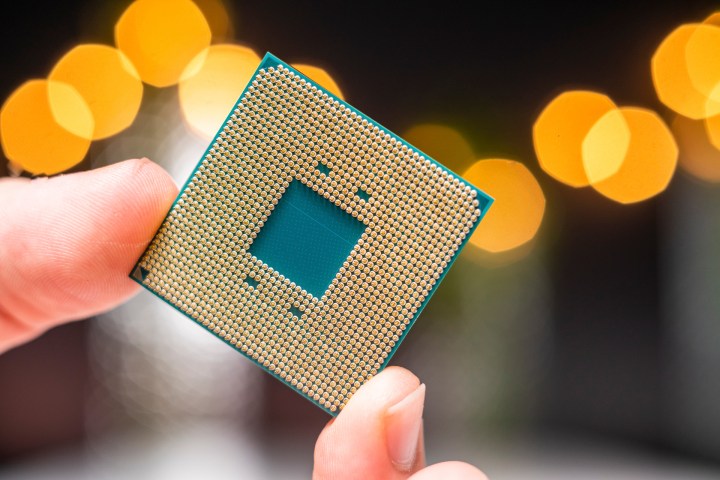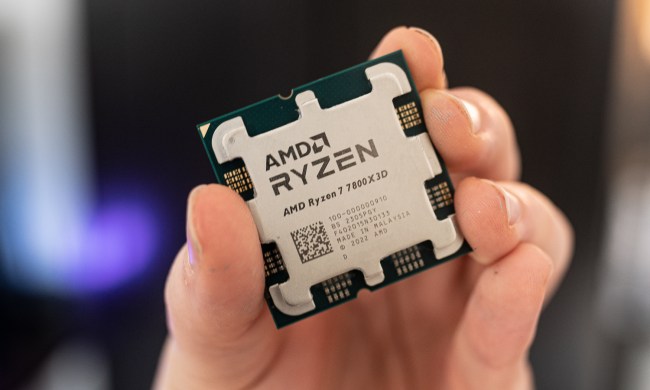AMD’s comeback over the past couple of years has reached a new level with its Ryzen 5000 processors. The desktop CPUs have already been announced, from the Ryzen 5 5600X up to the insanely powerful Ryzen 9 5950X, and the results are stunning.
The mobile counterparts to Ryzen 5000 are releasing soon for laptops, too. Ryzen 5000 represents a nomenclature jump from previous generations. Instead of the expected Ryzen 4000 range, in line with the Zen 2 mobile CPUs released in 2020, the new desktop CPUs jumped ahead to Ryzen 5000. In 2021, mobile will catch up, using the same Ryzen 5000 naming scheme.
Pricing and availability

AMD officially announced the Ryzen 5000 series on October 8, 2020, with a lineup of four distinct desktop CPUs. The company’s latest processor became available on November 6, 2020, with the 5600X priced at $299, the 5800X at $449, the 5900X at $549, and the 5950X at $799.
Finding them for the listed prices is a different story. As is the case with a lot of new PC hardware, Ryzen 5000 series processors are out of stock at most retailers. The 5600X and 5800X show up occasionally, but for the most part, you won’t be able to casually buy one of these processors. As of January 2021, however, stock is slowly starting to build back up, especially at brick and mortar retailers like Micro Center. We expect to see more plentiful stock in the next few months.
AMD’s Ryzen 4000-series mobile processors were announced at CES 2020, and took the better part of the year to proliferate among laptop manufacturers. We expect AMD to follow suit with mobile Ryzen 5000, with AMD announcing a 50% increase in laptop models during its CES 2021 keynote. Given the strong reception to Ryzen 4000-powered laptops, we expect a wide variety of manufacturers to build notebooks ranging from slim-and-light to robust mobile gaming rigs.
Architecture

At the heart of both the desktop and mobile parts is AMD’s Zen 3 architecture. It builds upon the success of Zen 2, with some significant architectural changes that lead to performance enhancements. With Zen 3, AMD is focused on improving gaming performance, with CEO Lisa Su stating that the company is already “the highest in multi-threaded performance and the best in efficiency.”
While based on the same 7nm process node as Zen 2 and leveraging the same chiplet layout, Zen 3 moves from a four-core CCX design to a unified eight-core CCX instead. That allows for sharing of L3 cache among a greater number of cores, effectively letting individual cores access twice as much cache as before. Cache latency is reduced, which could have a measurable effect on gaming performance. The company revealed that it began its work on Zen 3 more than five years ago.
Wider Float and Integer engines, advanced load/store flexibility, and a new “zero bubble” branch prediction system allow, as AMD claims, as much as a 19% improvement in instructions per clock (IPC). As we’ll get to next, benchmarks back up those claims.
That’s greater than even the most optimistic rumors had suggested. Ryzen 5000 has borrowed many of the enhancements from AMD’s Epyc Rome server CPUs, which also benefit from a unified cache design. Looking ahead, AMD confirmed that it will be moving to a 5nm process once Zen 4 debuts.
Performance
Third-party reviews are a must for confirming real-world performance, and AMD’s new Zen 3 architecture delivers stellar performance based on benchmarks. Many reviewers confirmed AMD’s stated claims of a 19% improvement in instructions per clock when moving from Zen 2 to Zen 3 on Ryzen 5000.
| Ryzen 5600X | Ryzen 5800X | Ryzen 5900X | Ryzen 5950X | |
| Cores | 6 | 8 | 12 | 16 |
| Threads | 12 | 16 | 24 | 32 |
| L2+L3 Cache | 35MB | 36MB | 70MB | 72MB |
| Base clock | 3.7GHz | 3.8GHz | 3.7Ghz | TBD |
| Max single-core boost clock | 4.6GHz | 4.7GHz | 4.8GHZ | 4.9GHz |
| TDP | 65W | 105W | 105W | 105W |
In its benchmarking, PCWorld noted a 20.7% performance increase going from a Ryzen 9 3900X to a Ryzen 9 5900X, for example. Compared to Intel’s 10th-Gen Core i9-10900K, AMD’s latest processor blows the competition out of the water.
The publication noted that the 16-core Ryzen 9 5950X outperforms the 10-core Core i9 by 36%. What’s more incredible is that when using the Cinebench R20 test, AMD’s 16-core processor even outperforms Intel’s premium 18-core Core i9-10980XE by as much as 19%. The 4.9GHz Ryzen 9 5950X delivers the highest single- and multi-core performance, at least in the consumer market.
Additionally, to show the strength of Ryzen’s performance, AMD revealed during the 5000 series’ unveiling that the 5900X was the first processor to break the 600-score barrier at stock speeds, easily outpacing the Intel Core i9 10900K. AMD’s own chart-topping results were subsequently confirmed by many media outlets in their early reviews, with sites declaring Intel’s gaming advantage largely wiped out by the latest Ryzen generation.

AMD’s Ryzen 3000 processors already outclassed Intel’s best in general CPU benchmarks, but Intel held on to the gaming crown by the skin of its teeth. Ryzen 5000 changed that. The 12-core 5900X shot ahead of Intel’s best in synthetic benchmarks, and matched or exceeded Intel when it comes to real-world benchmarks. Intel’s flagship 10900K can still outclass the 5900X by a hair when overclocked, especially in games that are more GPU intensive, such as Far Cry 5 and Borderlands 3, but Intel is no longer the definitive king.
Interestingly, AMD holds the crown when it comes to CPU intensive games. The 5900X leads the pack in games like Red Dead Redemption 2 and Hitman 2, both of which heavily stress the CPU with a lot of AI-driven NPCs.
At the top, AMD and Intel are still competitive. However, at the mainstream level, AMD is winning. The unassuming Ryzen 5 5600X shows just how far AMD has come in terms of gaming. In many titles, the 5600X beats Intel’s i7-10700K, and far surpasses the i5-10600K (the processor the 5600X is directly competing with). When dropping below the flagships, AMD not only maintains a lead over Intel, but increases it.
The mainstream chips aren’t just good at gaming, either. In Cinebench R20’s single-threaded test, the 5600X actually beats Intel’s 10900K. In real-world performance, the 5600X matches the 10700K in Premiere Pro, falling slightly behind the more expensive processors.
Benchmarks across the board show that Zen 3 is a significant step forward for AMD. It’s been a slow battle, but the tables are finally turning. The Zen 3 architecture has put AMD in a dominating position in gaming and productivity, from the six-core 5600X all the way up to the 16-core 5950X.
Mobile Zen 3

AMD announced its Zen 3-powered mobile processors at CES 2021. Three specific products were announced: The Ryzen 7 5800U, Ryzen 9 5900HX, and Ryzen 9 5980HX. Although we expect to see more processors in this range, AMD at least showed its roadmap moving forward. U-series processors are for thin and light laptops with a TDP of 15W, while the HX-series is for high-performance laptops, overclockable with a TDP of 45W+.
Although understated during the presentation, we expect a fairly significant performance increase with Ryzen 5000 mobile CPUs. Ryzen 4000 was already impressive, but with Zen 3’s IPC and memory improvements, Ryzen 5000 should be even more so.
| Processor | Speeds | L2 + L3 Cache | Cores/Threads | TDP |
| Ryzen 9 5980HX | Up to 4.8GHz | 20 MB | 8 cores, 16 threads | 45W+ |
| Ryzen 9 5900HX | Up to 4.6GHz | 20 MB | 8 cores, 16 threads | 45W+ |
| Ryzen 7 5800U | Up to 4.4GHz | TBD | 8 cores, 16 threads | 15W |
Leading the lineup is the Ryzen 9 5900HX, an eight-core, 16 thread processor that can boost up to 4.6GHz. AMD didn’t provide any firm benchmarks, just comparisons to Intel’s competing 10th-gen mobile processor: The i9-10980HK. According to AMD, the 5900HX boasts a 13% improvement in single-threaded performance, a 19% improvement in game physics performance, and a 35% increase in overall CPU performance.

As usual, it’s important to not take these numbers as gospel. They come from AMD directly, so may be subject to cherry-picking. However, AMD also made bold claims about the performance benefits of desktop Ryzen 5000 CPUs, most of which turned out to be true.
Below the 5900HX is the Ryzen 7 5800U, which is targeting thin and light notebooks. But you wouldn’t know that by the specs. Despite a TDP of only 15W, the 5800U comes with eight cores and 16 threads with a max boost of 4.4GHz. Once again, AMD made bold claims about the performance of this processor during its CES 2021 conference.
Compared to the competing i7-1185G7, AMD claimed improvements in video encoding by up to 44%, design and visualization by up to 39%, and digital content creation by up to 18%. Like the 5900HX benchmarks, you shouldn’t take the numbers too seriously until third-party benchmarks show up. AMD also didn’t clarify the full configurations for each benchmark.

Outside of performance, battery life is very important for the 5800U. AMD claimed up to 17.5 hours of general usage and up to 21 hours of movie playback with the 5800U. Again, however, we’ll need to wait until third-party benchmarks.
AMD didn’t provide any benchmarks for its top-of-the-line Ryzen 9 5980HX, but it should perform slightly better than the 5900HX. It’s nearly identical, down to the same 20MB of combined L2 and L3 cache. The only difference is that the 5980HX can boost up to 4.8GHz.
You should see these processors a little more commonly, too. AMD said it’s aiming for 150 notebook models powered by Ryzen 5000 mobile processors, the first of which should start releasing February 2021.
The AM4 socket remains, for now

One of the best features of AMD’s Ryzen desktop CPUs has been their inter-generational support of the same AM4 socket. Those who bought older-generation Ryzen CPUs and motherboards have been able to upgrade their processors without the need to buy a new motherboard — they just need to update the BIOS. That will be the case with Zen 3 Ryzen 5000 processors too, though this will be the last generation of Ryzen chips to use the AM4 socket.
The Ryzen 5000 CPUs will support existing X570 and B550 boards with a BIOS update, as well as select X470 and B450 boards, with a non-reversible BIOS update if manufacturers choose to support it. There has been no news on a Zen 3 specific chipset, though rumors of an x670 design have been around for well over a year.
Some suggested that it would feature enhanced PCIe Gen 4.0 support, as well as increased I/O from additional M.2, SATA, and USB 3.2 ports. Wccftech reported that native Thunderbolt 3 support still may not happen on this chipset.
AMD’s next-generation Zen 4 CPUs, expected in 2021, will move beyond AM4 to a new AM5 socket design that’s alleged to be built around technologies such as DDR5 memory and PCIe 5.0, according to Wccftech. If it’s arriving in 2021, it’s safe to assume that we won’t get X670 boards, with AMD likely working on an entirely new chipset and socket.




